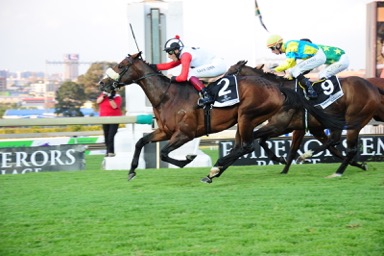Johan’s Big Four ~ Ashleigh Hughes (Love Racing)
What is it that makes certain trainers rise straight to the top of their profession, and stay there? What do they have, that so many others don’t? Is it luck? Where one special horse ‘puts them on the map’? Perhaps some are talented horsemen, while others are hard workers? Is there a formula to this sort of success in training racehorses?
As I chatted to Johan Janse van Vuuren, I realised that, every one of those things have contributed to his immense success, in just 3 and a half years of training under his own name. His most successful raceday to date, was having a “Quartet” of feature wins on the Charity Mile raceday on 5 November 2016 at Turffontein Racecourse. The day’s win streak started off with Girl On The Run winning the 1800m Gr3 Yellowwood Handicap, with Randall Simons in the irons. Barely 2 hours later he was back in the Winner’s Circle with She’s A Giver, who won the 1400m Gr3 HSH Princess Charlene of Monaco Starling Stakes very easily, by 3.75 lengths, giving jockey Gavin Lerena the second of his 4 wins on the day.
A very long rain delay, pushed the start of the main feature, the R1 Million Gr2 Peermont Emperor’s Palace Charity Mile, forward by nearly two hours. It’s a unique concept for a race – there are 16 runners, who race over 1600m. Each horse is assigned a charity, as well as a local celebrity and media house, who do a lot of publicity and promotions for the race, in the lead up to the day. All the charities are given a donation, but the one associated with the winner, gets the lion’s share. The Janse van Vuuren yard had the favourite in the race, the Australian import, New Predator, who was again ridden by Gavin Lerena.
New Predator (Aus) powered to victory in the Charity Mile, having had a dream run throughout the race, sitting second on the rail around the turn, and having a clear run in the home straight. It was an extra special win for the jubilant Lerena family, as Gavin’s cousin, Kevin Lerena, who is the current South African Cruiserweight Boxing Champion, was the celebrity paired with New Predator. The Peermont Educational Trust Bursary Program was the beneficiary of the R100 000 first prize. It was a very emotional lead in for everyone, which due to a 2 hour rain delay, the owner of New Predator, Laurence Werners unfortunately missed, as he had had to catch a flight to London!
The very next race on the card was the Gr3 Graham Beck Stakes, a 1400m for 3yo colts and geldings. Johan’s horse Doosra, again ridden by Gavin Lerena, managed to prevail over the Mike de Kock trained Heavenly Blue (Aus), in a thrilling heads up, heads down battle to the line. Both Johan and Gavin had 4 feature race winners apiece, and both have described the day as being close to their most successful day at the races.

Johan’s horse Doosra, again ridden by Gavin Lerena, winning the Graham Beck Stakes, a 1400m for 3yo colts and geldings.
Your 4-timer of feature wins on Charity Mile Raceday must be close to your most successful day at the races? How did it feel, as the day was unfolding, to realise that you had gotten everything so spot on for each horse?
“I was actually quite relaxed on the day, as most of the preparations had gone very well. After our first win with Girl On The Run, I got slightly more confident. But then She’s A Giver won, and I got really confident with the other two colts, because I thought, on the day, New Predator and Doosra were my best two runners.”
And were there any challenges leading up to the day?
“Everything went really smoothly in the last two weeks leading up to the raceday, and the only slight hiccup we had was when She’s A Giver had a slightly elevated temperature the night before – it’s was just 38.4C, so I called my vets to come and evaluate her. They said there wasn’t much we could do, and we gave her some antibiotics, and reassessed her the next morning. She ate up well that night, and she responded to the treatment, and so we decided to take our chances and raced her”
Those sort of successful days are a long time in planning, and a lot of team work is involved. Who are the key members of your team, and what are their roles? “
Yes, I’ve got a lovely team of hard working guys working for me at the moment. My main Assistant Trainer in the yard is Clinton Naude, and he heads up the team. I also have Kingston, who is from Zimbabwe – he is excellent. He is in charge of his own yard, within my stable, and he is very capable. He would be able to train his own string really well, if he ever decided to take out his licence, as he is very clued up. I also have Randall Simons who rides a lot of work at home for us. He is very professional, and I value the feedback he gives me. Hennie Greyling also does a lot of work riding for us. The vets are also an integral part of my team. I like to treat horse’s injuries proactively, trying to prevent injuries and problems, instead of waiting for them to happen, and then trying to fix them afterwards. My owners tell me that I really like the vets a lot, but I have learnt so much from them, and I rely on them a lot. These guys all do their bit, and none of my success would be possible without their dedication and hard work.”
Who are your biggest clients, and what sort of relationship do you have with them?
“I have two big clients in my yard, Laurence Werners and Jaap van der Vendal, and they have both supported me staunchly from day one. I have a very good professional relationship with both of them, and they are actually quite similar, in that they are very straight and to the point, much like myself. And so I get on with them both really well and we understand each other, which make things so much easier. They have actually become more than just clients though, as they have grown with me and my yard.”
Are you involved in selecting the horses that come into your yard from the sales? Do you do all the legwork yourself, or do you have a trusted advisor or bloodstock agent who helps you? You were always very keen on studying and researching bloodlines and pedigrees.
”I still do a lot of studying of pedigrees, and I still really enjoy it. I am a great believer in certain crosses with horses – certain sire lines will match better with certain female lines. So when the sales catalogues come out, I go through the book and earmark the pedigrees which I know my clients will also like, and then we go to the sales to assess those horses’ conformations to make our final choices. I have always been a massive fan of Fort Wood as a sire, and now also as a broodmare sire, and there are a lot of really good new sires which I think cross very well with the Fort Wood mares. I do most of the selections of horses myself at the sales. Sometimes a client may ask me to go and look at specific horse for them as well. But after seeing all the horses with the pedigrees we like, I sit down with my clients to decide which ones we like, and are going to bid for.”
How did you start out in the industry? What ignited your passion?
”I’ve been involved with horseracing for most of my life – as long as I can remember to be honest with you. My late Grandfather had a few share in racehorses, and his brother was also a few mares, which he bred from. I don’t think they were too successful at it though. I used to go racing, from a young age, with my father and grandfather, and I used to study the Computaform a lot more than I ever studied anything at school! I could not wait to finish school every day, so that I could get down to the local tote to put my Place Accumulator on that day’s racing. I used to get a few Rand for our school lunches, but that was used to pay for the bets instead. We would study form during our first break, and then run the 3km down to the tote after school, to get there in time to place our bets.”
You became a licenced Trainer in 2013, after having a 13 year tenure as an Assistant Trainer to former Champion Trainer, Geoff Woodruff. What are some of the most important things you’ve brought forward from there?
“It was very easy working for Geoff. He was always very forthcoming his knowledge, and when he gave us instructions to do something, he was always happy to explain why we had to do it. One of the main things I learnt from Geoff, is that you have to be confident when you make decisions. If you feel something is right, you must go with your gut feel and do it. Don’t second guess yourself when it comes to difficult situations”
How many horses in your string currently? Are you taking a string down to Cape Town for the season?
“I currently have 120 horses in my string, but I would like to cut back slightly to between 100 and 110. I just feel that it’s a more manageable number for my team. No I am not taking a string down to Cape Town, but I have sent New Predator and She’s A Giver down to Brett Crawford, to look after for us, as he did so well with Brazuca last year for us”
Racehorse trainers are famous for having superstitions or lucky charms, or certain things which they do on racedays, what are yours?
“I am a fairly superstitious person, but there is nothing I specifically do on racedays. Laurence Werner’s wife Tessa is a big believer of the balance of feng shui, and she has identified me as a ‘number 1’, which makes me a leader, and I have the strong personality that goes with it. She’s given me a couple of tips to use this to my advantage, which includes me wearing either water or metal colours at races, the blues or greys, as that is supposed to make me stronger”
Do you have any advice for any young people aspiring to become a trainer one day?
“Horseracing is a very tough industry, and one thing I do know, if you are not committed, and if you aren’t prepared to put in the long hours, then it’s not really worth your while pursuing a career in racing. It consumes most of your life, most of your time, and it becomes a lifestyle more than a job. But hard work definitely pays off!”










